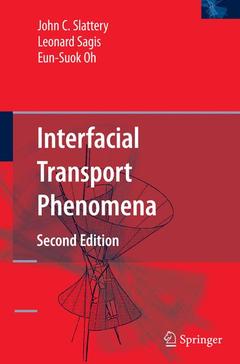Description
Interfacial Transport Phenomena (2nd Ed., Softcover reprint of the original 2nd ed. 2007)
Authors: Slattery John C., Sagis Leonard, Oh Eun-Suok
Language: English
Subjects for Interfacial Transport Phenomena:
Keywords
Helium-Atom-Streuung; continuum mechanics; design; kinematics; mechanics
210.99 €
In Print (Delivery period: 15 days).
Add to cart
Interfacial Transport Phenomena
Publication date: 10-2016
Support: Print on demand
Publication date: 10-2016
Support: Print on demand
Approximative price 210.99 €
Subject to availability at the publisher.
Add to cart
Interfacial transport phenomena (2nd Ed.)
Publication date: 12-2006
828 p. · 15.5x23.5 cm · Hardback
Publication date: 12-2006
828 p. · 15.5x23.5 cm · Hardback
Description
/li>Contents
/li>Comment
/li>
Transport phenomena is used here to describe momentuin, energy, mass, and entropy transfer [1, 2]. It includes thermodynamics, a special case of which is thermosiaiics. Interfacial transport phenomena refers to momentum, energy, mass, and entropy transfer within the immediate neighborhood of a phase interface, including the thermodynamics of the interface. In terms of qualitative physical observations, this is a very old field. Pliny the Elder (Gains Plinius Secundus, 23-79 A. D. ; Pliny [3]) described divers who released small quantities of oil from their mouths, in order to damp capillary ripples on the ocean surface and in this way provide more uniform lighting for their work. Similar stories were retold by Benjamin Franklin, who conducted experiments of his own in England [4]. In terms of analysis, this is a generally young field. Surface thermostat ics developed relatively early, starting with Gibbs [5] and continuing with important contributions by many others (see Chap. 4). Derjaguin and Lan dau [6] and Verwey and Overbeek [7] indicated how London-van der Waals and electrostatic double-layer forces were to be incorporated in continuum mechanics, now often referred to as DLVO theory. But prior to 1960, there were relatively few notable papers concerned with the analysis of dynamic systems. Two stand out in my mind. Boussinesq [8] recognized the surface stress tensor and proposed the constitutive equation that we now refer to as the Boussinesq surface fluid model (Sect. 4. 9. 5).
Kinematics and Conservation of Mass.- Foundations for Momentum Transfer.- Applications of the Differential Balances to Momentum Transfer.- Foundations for Simultaneous Momentum, Energy, and Mass Transfer.- Applications of the Differential Balances to Momentum, Energy and Mass Transfer.
Revised and updated extensively from the previous edition Discusses transport phenomena at common lines or three-phase lines of contact Provides a comprehensive summary about the extensions of continuum mechanics to the nanoscale
© 2024 LAVOISIER S.A.S.
These books may interest you

Advances in Transport Phenomena2010 210.99 €



